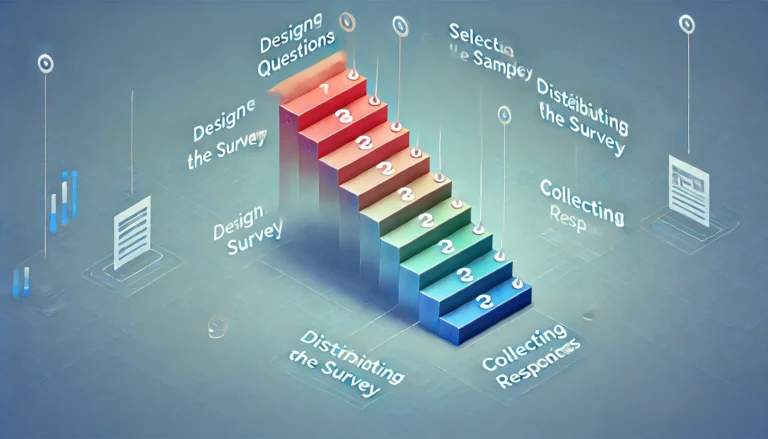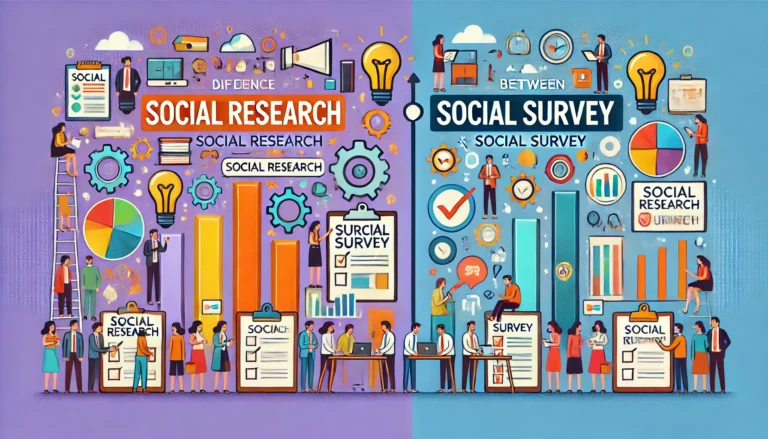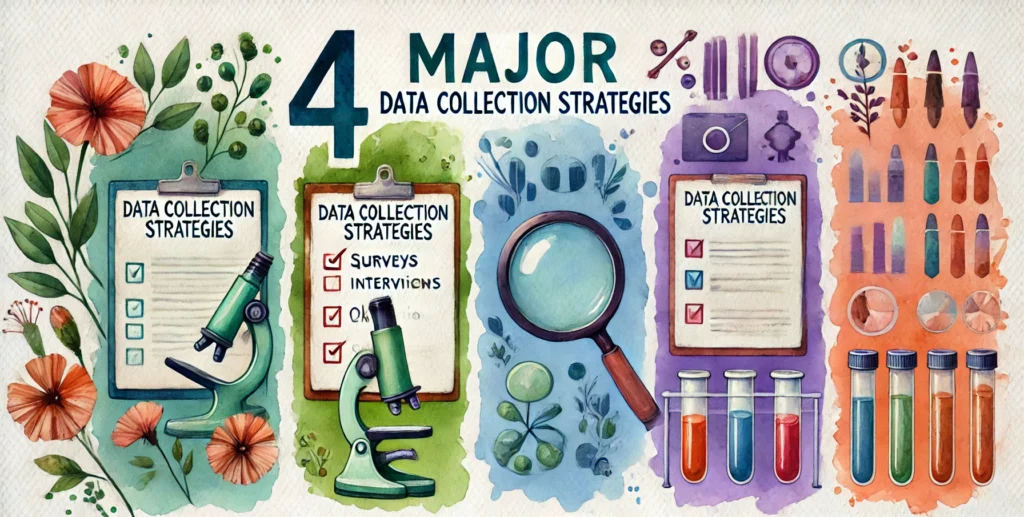Data Collection Strategies
The data collection strategies refer to the ways researchers access the research situation using tools for data collection. In research, some situations can be under greater control of the researchers than other situations; for example, data collection from the employees of an organization is comparatively more controlled than gathering data from the customers.
Similarly, conducting research in a laboratory is more controllable than doing the same in the field. Therefore, variation in control on accessing and collecting data determines different data collection strategies such as:
- Experiment Click here to explore
- Case-Study Click here to explore
- Observation Click here to explore
- Survey
Survey
Survey research is a systematic research strategies that uses prescribed questionnaires or interviews to gather data about individuals, including their preferences, thoughts, and actions.
When the population of the study is too large and difficult to access or control, then a representative portion is selected for data collection. Survey research means collecting information about a group of people by asking questions and analyzing the results.
- Survey is a scientific method for the study of current social problems with definite geographical limits.
- By Begurdus: A survey is a collection of data concerning the living and working conditions, broadly speaking, of the people in a given community.
Steps of Conducting a Survey

There are following steps for conducting a survey;
Step 1 – Define Population and Sample
Prior to commencing survey research, like other data collection strategies it is imperative to possess a well-defined research question that highlights the specific information you seek to discover. To address this inquiry, it is imperative to identify the exact population group that will be the focus of the survey.
Populations
The target population refers to the particular population one seeks to gather information on. This group can encompass a wide range of individuals or be limited to a specific subset. The objective of your survey should be to provide outcomes that can be generalized to the entire population.
Therefore, it is imperative to carefully establish a precise definition of the specific individuals or groups from whom you wish to derive conclusions. If your survey is not generalizable, it might lead to many typical research flaws, including sample bias and selection bias. The presence of these biases has serious repercussions for the validity of your results.
Samples
Surveying the complete population of your research is seldom feasible due to the challenge of obtaining responses from every individual. Instead, you will often collect data from a subset of the entire population which is common in other data collection strategies as well. The size of the sample is dependent upon the size of the population. An online sample calculator may be utilized to determine the required number of replies.
Several sampling strategies enable the generalization to large populations. Generally, the sample should strive to be a true reflection of the entire population. The greater the size and representativeness of your sample, the more reliable your results will be.
Step 2 – Development of Instrument
The second phase is to develop an instrument—a survey questionnaire or interview schedule. Respondents read the questions in a questionnaire themselves and mark the answers themselves. An interview schedule is a predetermined list of questions that are verbally presented to the respondent by an interviewer, who is responsible for recording the answers.
At this point, it is necessary for you to make a decision on the specific questions you will present and the manner in which you will ask them. One must take into account:
- The type of questions (open-ended or close-ended questions)
- The content of the questions
- The phrasing of the questions
- The ordering and layout of the survey
In the case of close-ended questions, the researcher has to decide on scales and categories against each section or question, whereas, in the case of open-ended questions, the question does not provide any predefined options for selection. Conversely, the respondent provides their own verbal responses.
Step 3 – Pilot Test
Before conducting the actual survey you should have pilot test the tool with a small set of respondents who are similar to those in the final survey. If you use interviewers, you must train them with the questions.
In the pilot test and interviewer training, you ask respondents and interviewers whether the questions were clear, and you need to explore their interpretations to see whether your intended meaning was clear.
Step 4 – Conducting a Survey
Prior to commencing, establish a well-defined strategy including the specific location, timing, methodology, and participants for the survey. Prioritize the determination of the desired number of replies and the method by which you will obtain the sample.
Once you are satisfied with the development of a rigorous research design that is appropriate for addressing your research questions, you may proceed with administering the survey using your preferred mode, such as via mail, online, or in person.
Step 5 – Analyze the Results
There are several approaches to evaluating the outcomes of your survey. Initially, it is necessary to manipulate the data, often with a computer program, in order to arrange all the received inputs in a systematic manner. Additionally, it is advisable to perform data cleansing by eliminating missing or inaccurately filled-out replies. To categorize and organize replies, you need to provide labels to each response and organize them into groups or themes when you ask open-ended questions.
Additionally, one can employ qualitative methodologies, such as thematic analysis, which is particularly well-suited for studying interviews. Statistical analysis is commonly performed with software such as SPSS or Stata. A similar set of survey data can be subjected to many analyses.
Step 6 – Report Writing
Ultimately, after gathering and scrutinizing all the essential material, you will document it as a component of your thesis, dissertation, or research paper. In the methodology section, you provide a detailed account of the specific procedures and techniques used to carry out the survey.
Provide a detailed explanation of the question you used, the sampling technique utilized, the specific time and place for the survey, and the rate at which respondents participated. If applicable, you may attach the whole questionnaire and make references to it in the text.
Begin the study by providing a detailed explanation of the data preparation process and the statistical techniques employed for its analysis. In the results section, you provide a concise overview of the main findings derived from your investigation. In the discussion and conclusion section, you provide your explanations and interpretations of the data, address the research question, and analyze the effects and limitations of the research.
Advantages of Survey

Covers Wider Population
Surveys has a significant capacity to accurately reflect a vast population. Surveys have the advantage of extracting data that closely represents the characteristics of the wider population, in comparison to other data collection strategies.
Low Costs
When conducting surveys, the only cost you need to cover is the manufacturing of survey questionnaires. Conversely, alternative techniques of collecting data, such as focus groups and personal interviews, necessitate researchers to pay additional costs.
Convenient Data Collection
Surveys may be conducted with participants using several methods. The surveys may be conveniently transmitted by email or administered online.
Currently, the online survey strategies is widely used to collect data from specific participants. In addition to the simplicity of data collection, researchers have the capability to obtain data from individuals worldwide.
Highly Representative
The survey approach is highly representative, making it easier to uncover statistically significant findings compared to other data-gathering methods. Surveys may be used to investigate multiple variables with effectiveness.
Ensures Greater Reliability
Surveys are good for scientific research projects because they offer all participants a standardized experience. By achieving a high level of dependability, the researcher’s biases are removed.
Accuracy
Survey questions are subject to careful examination and standards to ensure that they offer similar meanings to all respondents completing the questionnaires. Consequently, there is a higher level of accuracy when measuring the collected data.
Disadvantages of Surveys
Inflexible Technique
The survey and its administration technique are fixed and cannot be altered during the whole data collection period. While the inflexibility of the survey approach may be seen as a drawback, it may also be seen as an advantage due to the ability to maintain precision and impartiality in the study.
Unfit for Controversial Issues
Controversial questions may not receive exact answers from participants due to the potential challenge of retaining relevant facts. The reality of these debates may need to be more clearly assessed when applying alternate data collection methods such as interviews and focus groups.
Possible Inappropriateness of Questions
Surveys always ensure that questions are standardized before being presented to the participants. Consequently, the researcher must formulate questions that are sufficiently broad to encompass the entire community. Nevertheless, these broad inquiries may not be suitable for all individuals involved.
Subjectivity in Responses
The primary issue with surveys is that individuals tend to be subjective rather than objective in their responses. Individuals are not similar to thermometers in the sense that they are incapable of offering completely reasonable replies to your survey.
Unintentional Biases
It might not even be that people intentionally respond inaccurately. It might be due to biases or considering fatigue, especially in the case of questionnaires and filling the questions speedily, even sometimes without reading the questions properly.
Difference between Social Research and Social Survey

Both are concerned with specific problems, places, persons, and human welfare, but the purpose and objective are different. A social survey is concerned with specific problems, places, and persons. It mostly deals with immediate problems whereas research study is concerned with more general problems and has general application.
Accumulation of Knowledge
Surveys rarely focus on the gathering of similar knowledge, as this falls under the domain of social research. Surveys do not prioritize the direct advancement of knowledge, while research actively contributes to the expansion and development of human knowledge.
Surveys are Intensive, and Research is Extensive
Surveys are intensive in nature, while researches are more extensive. Surveys are generally on the superficial level of limited studies. They do not go deep into this subject matter, whereas research study is usually an in-depth investigation.
Cooperative Efforts
Surveys are complex and large-scale understandings that require co-efforts, whereas research may not necessarily require cooperative efforts.
Solution and Testing
Surveys are conducted to find urgent solutions, while research is conducted to test improvements. Surveys mostly focus on resolving specific issues, whereas the examination of concepts and hypotheses is the domain of social research.
Hypothesis
The purpose of research is to verify existing hypotheses and develop new ones. Consequently, the researchers must develop a hypothesis. Social surveys often prioritize the investigation of a specific situation rather than the creation and testing of hypotheses.
Scope
These are different in their scope. Survey studies only the numbers of the community while social research covers the whole human race as its results serve the whole world.
In short, research is theory-oriented, and surveys are problem-oriented. Which means;
Theory = Theoretical Problems = Practical
However, surveys are more practical, while research is more theoretical in nature. However, the findings of each can be useful for the other.
Comparison Chart
| Sr. No | Survey | Research |
| 1 | Concern with specific problems. | Concern with general problems. |
| 2 | Practical in nature | Scientific in nature or theoretical in nature (theory-based) |
| 3 | Leads to develop a hypothesis. | Based upon hypotheses. |
| 4 | No need for the hypotheses | A great need for hypotheses. |
| 5 | Based on the professional skills. | Based upon scientific knowledge. |
| 6 | Minimum scope | Maximum scope. |
| 7 | Short time and less expense are required. | Long time and more expenses are required. |
| 8 | Not concerned with the reasoning. | Primarily concerned with the reasoning. |
| 9 | Simple in nature. | Complex in nature. |
| 10 | Insured no accuracy. | Insured the great accuracy. |






